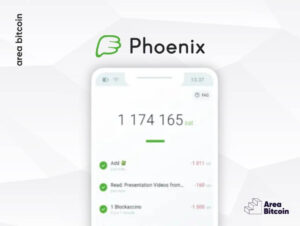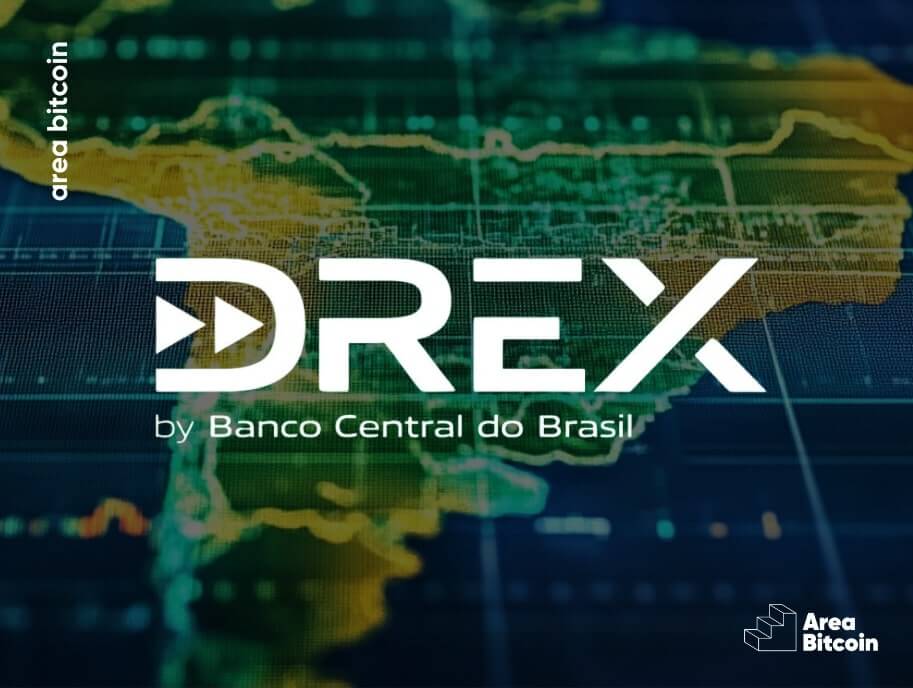For many, retirement and Bitcoin may not seem to go hand in hand, but that’s not entirely true. Bitcoin can help you achieve major goals, like early retirement, faster.
Just because Bitcoin is volatile doesn’t mean you should avoid accumulating satoshis. In fact, if used correctly, Bitcoin can accelerate your path to financial independence or sovereignty.
Those aiming to retire early typically set up an investment plan where accumulating assets over time generates enough passive income to cover their costs, without relying on work or government pension schemes, which often fail to keep up with inflation.
In this article, I’ll show you why diversifying your long-term portfolio with Bitcoin can make all the difference in your early retirement or financial independence strategy.
Is it feasible to retire with Bitcoin? Let’s find out!
Table of contents
Where does Bitcoin fit into the retirement plan?
To achieve financial independence, you need to accumulate assets that pay interest, dividends, rents, or appreciate in value, allowing them to grow exponentially over time.
In other words, through the power of compound interest and market asymmetries, your investments can grow large enough to sustain your lifestyle without eroding your wealth, so you only work if you choose to.
While Bitcoin doesn’t offer dividends or generate passive income, it’s a powerful asset that experiences parabolic value increases and is still in its early adoption phase.
Bitcoin doesn’t generate income but its value grows over time because it becomes increasingly scarce and valuable, much like collectibles or gold itself.
DCA Investment Strategy and Retirement
The Dollar Cost Averaging (DCA) strategy for Bitcoin involves investing a fixed amount at regular intervals, regardless of the coin’s current price. This method is popular among investors aiming to reduce the impact of market volatility.
Advantages of DCA in Bitcoin:
- Reduces the Impact of Volatility: By investing fixed amounts regularly, you buy more Bitcoin when prices are low and less when they are high. This can lower the average purchase cost over time.
- Simplicity and Discipline: Establishing a recurring investment plan eliminates the need to try “timing the market” or investing large sums all at once, which can be risky.
- Suitable for Beginners: It’s a straightforward strategy that is ideal for those new to Bitcoin investing.
- Long-Term Benefit: DCA works well for investors with a long-term outlook, as Bitcoin has shown significant appreciation potential over time.
How does DCA help you retire with Bitcoin?
Applying the Dollar Cost Averaging (DCA) strategy to Bitcoin can be an effective way to build a retirement portfolio.
By consistently investing a fixed amount in Bitcoin over time, regardless of market fluctuations, investors can steadily accumulate the asset for the long term.
This strategy fits well with retirement plans, as it encourages gradual growth while reducing the risk of significant losses from market volatility.
With Bitcoin being an emerging asset class with strong long-term appreciation potential, including it in a retirement portfolio through DCA offers valuable diversification and the potential for significant gains, helping secure your financial future.
Should I invest in Bitcoin to retire earlier?
If you’re still unsure about adding Bitcoin to your long-term portfolio, consider this study released by Grayscale in 2019:
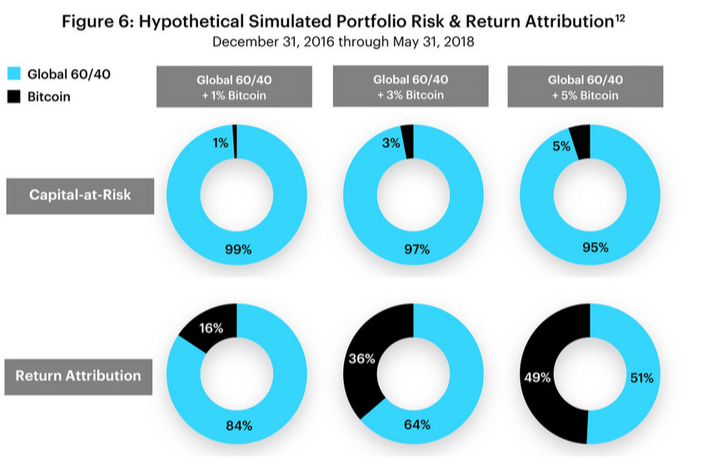
The data shows that even small allocations of Bitcoin, such as 1%, 3%, or 5%, can significantly improve portfolio performance:
- A portfolio that allocated 1% to Bitcoin saw its return increase by 16%;
- Those who allocated 3% saw their return increase by 36%;
- And those who allocated 5% performed 49% better.
This study highlights how small Bitcoin allocations can enhance returns without increasing portfolio risk.
We’ve also run calculations to illustrate this in practice, but before diving into that, here’s more key information:
Bitcoin’s scarcity, immutability, decentralization, and growing demand have driven it to appreciate far more than any stock, bond, or commodity over the past decade.
Bitcoin’s Asymmetry (CAGR)
Bitcoin’s asymmetry is remarkable, as shown below:
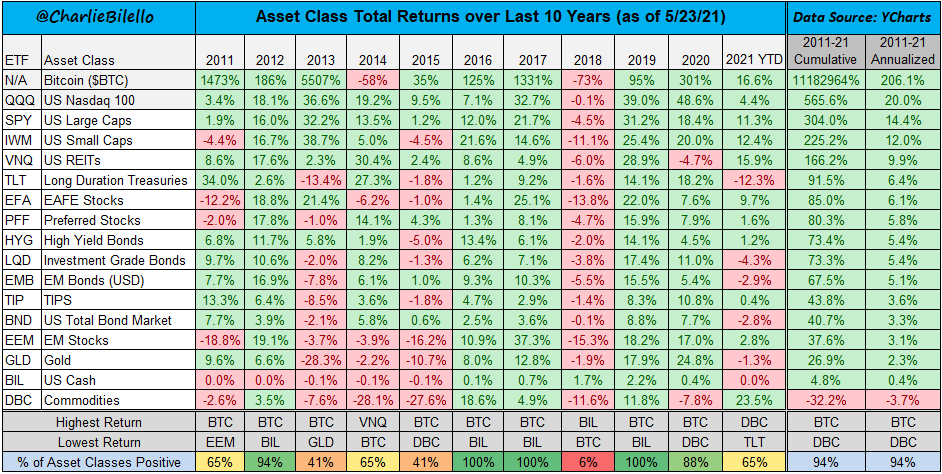
From 2011 to the end of 2021, Bitcoin had a Compound Annual Growth Rate (CAGR) of about 206%.
CAGR represents the average growth over time, from the initial investment to the point of calculation.
This 206% average far exceeds that of U.S. stocks (QQQ) at 14.4%, U.S. real estate (VNQ) at 9.9%, and U.S. government bonds (BND) at 3.3%.
In simple terms, $100 invested in Bitcoin, stocks, and bonds would yield vastly different results.
Bitcoin’s Scarcity
Some argue that past returns don’t guarantee future returns, but it’s undeniable that Bitcoin’s appreciation potential is still huge. This happens because Bitcoin is scarce, with only 21 million units available, and its functioning is mathematically predictable.
Bitcoin’s entire monetary policy has been programmed since 2009, and we already know how the network will function for the next 120 years.
For a deeper understanding, check out our article, What is Bitcoin Halving?
The table below illustrates Bitcoin’s predictability, driven by a pre-programmed, immutable, and transparent monetary policy since its inception.
| Event | Block Reward |
|---|---|
| Genesis | Reward per block: 50 |
| 2012 Halving | Reward per block: 25 |
| 2016 Halving | Reward per block: 12.5 |
| 2020 Halving | Reward per block: 6.25 |
| 2024 Halving | Reward per block: 3.125 |
| 2028 Halving | Reward per block: 1.5625 |
| 2032 Halving | Reward per block: 0.78125 |
| 2036 Halving | Reward per block: 0.390625 |
| 2040 Halving | Reward per block: 0.1953125 |
| 2044 Halving | Reward per block: 0.09765625 |
| 2048 Halving | Reward per block: 0.04882812 |
| 2052 Halving | Reward per block: 0.02441406 |
| 2056 Halving | Reward per block: 0.01220703 |
| 2060 Halving | Reward per block: 0.00610351 |
| 2064 Halving | Reward per block: 0.00305175 |
| 2068 Halving | Reward per block: 0.00152587 |
| 2072 Halving | Reward per block: 0.00076293 |
| 2076 Halving | Reward per block: 0.00038146 |
| 2080 Halving | Reward per block: 0.00019073 |
| 2084 Halving | Reward per block: 0.00009536 |
| 2088 Halving | Reward per block: 0.00004768 |
| 2092 Halving | Reward per block: 0.00002384 |
| 2096 Halving | Reward per block: 0.00001192 |
| 2100 Halving | Reward per block: 0.00000596 |
| 2104 Halving | Reward per block: 0.00000298 |
| 2108 Halving | Reward per block: 0.00000149 |
| 2112 Halving | Reward per block: 0.00000074 |
| 2116 Halving | Reward per block: 0.00000037 |
| 2120 Halving | Reward per block: 0.00000019 |
| 2124 Halving | Reward per block: 0.00000009 |
| 2128 Halving | Reward per block: 0.00000005 |
| 2132 Halving | Reward per block: 0.00000002 |
| 2136 Halving | Reward per block: 0.00000001 |
There is also significant scarcity in circulating Bitcoin, as the number of hodlers (who buy and hold BTC) continues to grow, along with corporations acquiring large volumes, storing them, and offering services that incorporate Bitcoin.
Companies like PayPal, Square, BlackRock, MicroStrategy, and major global banks are accumulating Bitcoin and incorporating it into their business models.
Growth in Bitcoin Holdings
The image below illustrates how Bitcoin holdings have increased since 2010, both among individual hodlers and financial institutions.
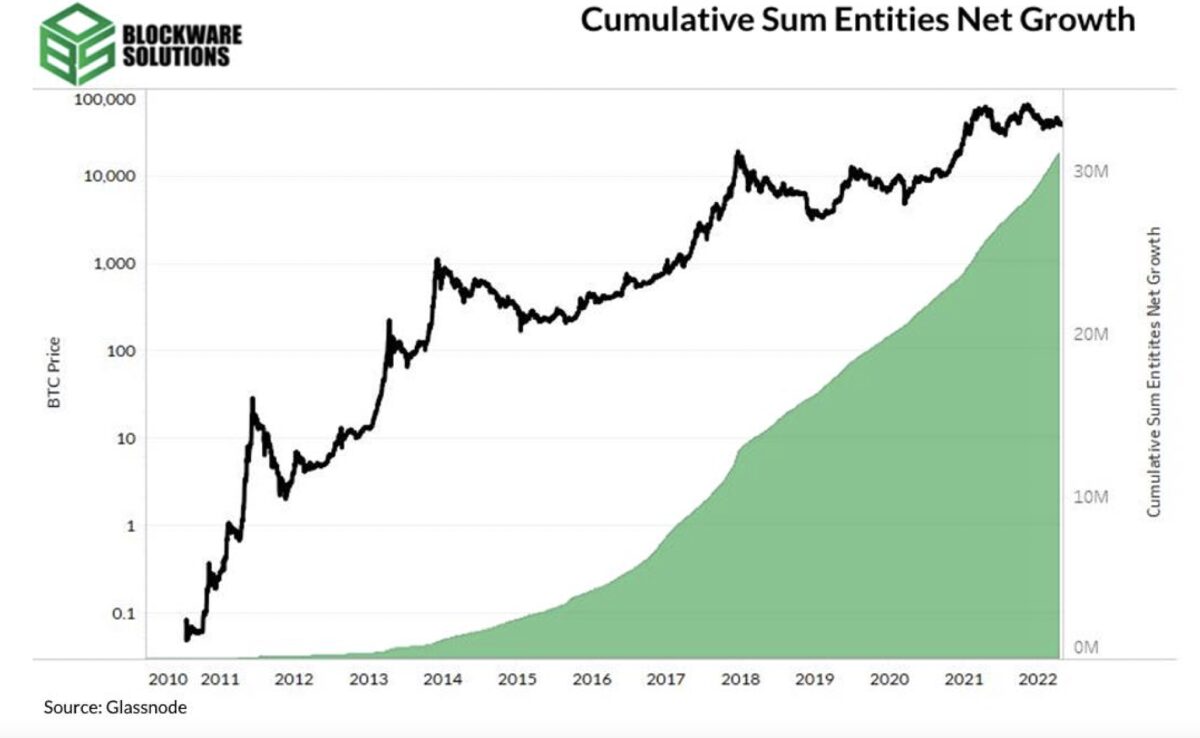
Bitcoin is gradually earning a place in portfolios as an asset independent of the fiat system.
As Greg Foss puts it:
“A hedge against the systemic risk of fiat currencies, banks, and sovereign debt defaults.”
Bitcoin has consistently made higher lows, and if we average its price, we see that despite volatility, the long-term trend shows upward appreciation.

Thus, despite the volatility, often criticized by market experts, Bitcoin has proven to be an asset with the best risk-return profile.
See how other assets have lagged behind when compared to Bitcoin’s performance over the past 10 years:
Even though short-term volatility may result in negative returns for a few months, those who have bought and held Bitcoin for at least five years have never experienced a loss.
Therefore, those who see negative results from Bitcoin are typically the ones with a short-term focus, selling impulsively or out of anxiety.
It’s just a matter of patience.
The image below demonstrates that Bitcoin has been profitable 85% of the time.
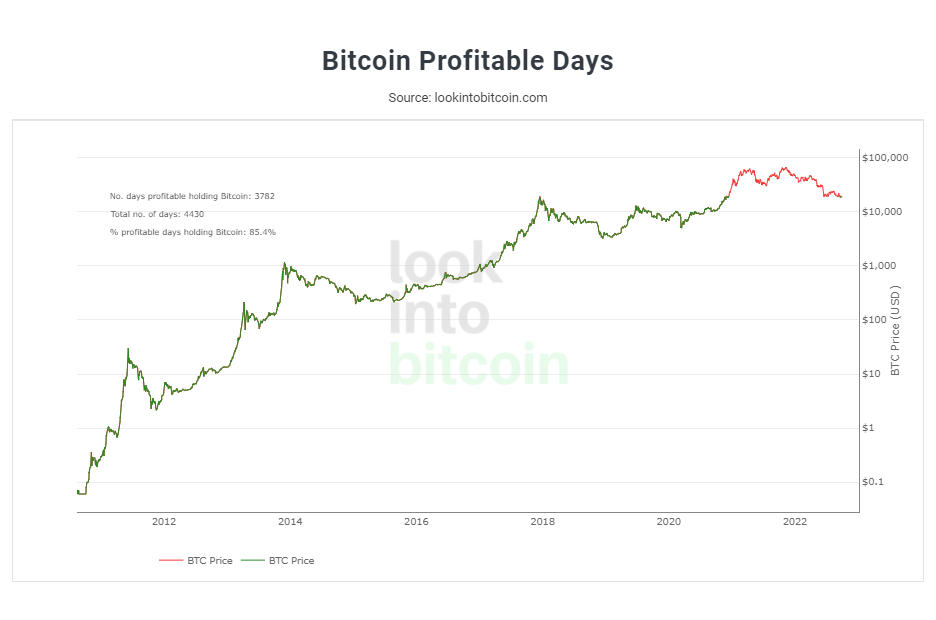
Additionally, in the table below, you can also see the ROI (Return on Investment) of Bitcoin compared to gold and U.S. stocks.
As shown, Bitcoin has overwhelmingly outperformed, delivering over 100,000% returns in dollars over the last 10 years, with only the past year showing negative results.
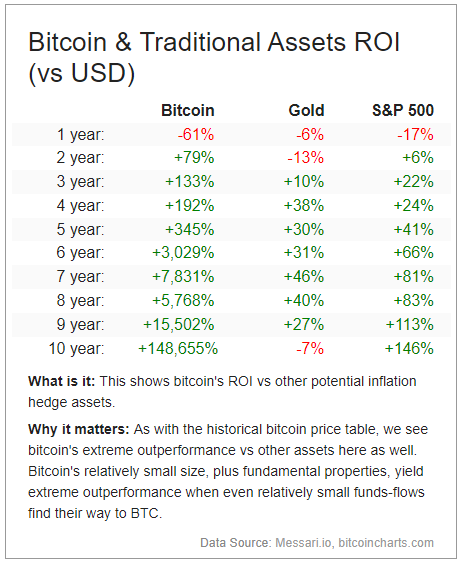
Portfolio performance simulation with and without Bitcoin
If the numbers alone don’t convey the full impact, let’s simulate the difference in performance between a portfolio with Bitcoin and one without.
Let’s assume your goal is to reach $1.5 million to achieve financial sovereignty. This would provide you with a passive income of around $5,000 per month, based on a diversified investment portfolio of fixed income and variable assets yielding an average return of 4% per year, adjusted for inflation, which is roughly 0.33% per month— a classic example in the financial market.
Now, let’s be conservative and assume Bitcoin doesn’t continue its 200% CAGR. Instead, we’ll assume it slows down to an average return of 40% per year.
Additionally, let’s assume you contribute $1,000 per month, with 5% ($50) allocated to Bitcoin and 95% ($950) to traditional assets, which yield an average return of 4% per year, adjusted for inflation. By the end of the year, you would have invested R$600 in Bitcoin and $11,400 in fixed and variable income assets.
On top of all that, let’s assume that monthly contributions of R$1,000 are made, with 5% (R$50) in Bitcoin and R$950 (95%) in traditional assets, yielding an average return of 4% per year, adjusted for inflation. This means that at the end of each year, a total of R$600 would be invested in Bitcoin and R$11,400 in fixed and variable income.
Let’s look at the results:
At the end of the first year, the difference between the portfolio with Bitcoin and the one without was $200—a notable difference, considering only 5% of the portfolio is allocated to Bitcoin.
However, over time, as contributions continue, this small allocation to Bitcoin significantly enhances the performance of the Bitcoin-inclusive portfolio compared to the one without.
Exponential effect gaining traction
After 20 years, the Bitcoin-inclusive portfolio appreciated 11 times more than the portfolio without Bitcoin, reaching $4 million, while the traditional portfolio without BTC remained around $300,000.
It’s worth noting that in this scenario, no profit-taking occurred, and the satoshis were held for the full 20 years. Interestingly, someone aiming for financial independence with R$1.5 million in assets would reach that goal around the middle of the 16th year with the Bitcoin-inclusive portfolio.
In contrast, the traditional portfolio wouldn’t reach the R$1.5 million mark even after 20 years, unless contributions were increased.
Keep in mind, this is an exercise based on Bitcoin’s average annual appreciation over the past decade.
There’s no guarantee that Bitcoin will continue to appreciate at the same rate, and it’s important to understand Bitcoin’s characteristics and your own investor profile before making any investment decisions.
*This article is for study purposes only and should not be considered investment advice. It’s essential to conduct thorough research and analysis before making any purchases.
Is it possible to retire earlier with Bitcoin?
Yes, as we’ve explored throughout this article, the potential is truly eye-opening, right?
The main challenge is that while many people recognize the opportunities and benefits of Bitcoin, they struggle to maintain their investments when faced with market realities.
Many sell their Bitcoin for quick profits, or out of fear during downturns caused by volatility.
There are countless stories of people who bought Bitcoin when it was dirt cheap—at prices like a few cents—only to sell when it hit $1 or $10.
While they made profits, they missed out on the incredible parabolic rises that followed.
The key mistake is selling Bitcoin based solely on price fluctuations, without considering the long-term transformation it can bring. This is why Michael Saylor emphasizes that Bitcoin is an asset to hold for at least 100 years, as we are only beginning to explore the potential of the Internet of value.
So, let’s strengthen our resolve and hold onto Bitcoin for the next 20, 30, or even 50 years, as we are still in the early stages of an adoption wave yet to fully unfold!
Share on your social networks:

One of the leading Bitcoin educators in Brazil and the founder of Area Bitcoin, one of the largest Bitcoin schools in the world. She has participated in Bitcoin and Lightning developer seminars by Chaincode (NY) and is a regular speaker at Bitcoin conferences around the world, including Adopting Bitcoin, Satsconf, Bitcoin Atlantis, Surfin Bitcoin, and more.
Did you like this article? Consider buying us a cup of coffee so that we can keep writing new content! ☕



